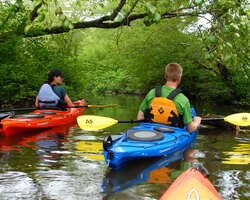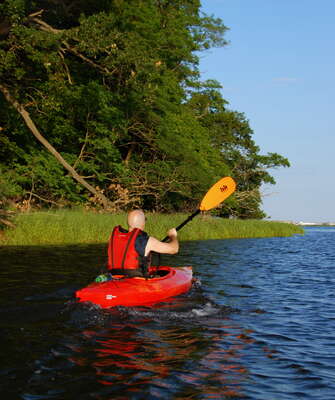
Kayaking is an exciting water activity that lets you explore lakes, rivers, and coastal areas while paddling at your own pace. Whether you're seeking a peaceful glide across a calm lake or the thrill of navigating river rapids, kayaking offers a versatile experience for all skill levels. Beyond the fun, kayaking is excellent for your health, providing a full-body workout and a wonderful way to unwind in nature.
This article will cover..
In this article, we’ll introduce you to the basics of kayaking, including how to get started, the essential gear you’ll need, the differences between entry-level and advanced equipment, tips for your first kayaking trip, and enjoyable activities to do while kayaking.

Getting started with kayaking is straightforward and beginner-friendly. Look for local kayaking clubs or rental shops that offer beginner lessons. Starting on calm, flat water such as a lake or slow-moving river is ideal. This setting allows you to practice your paddling techniques and get comfortable with your kayak in a safe environment.
To help you get familiar with kayaking, here are some common terms you might encounter:
- Cockpit: The area where the paddler sits.
- Hull: The bottom part of the kayak that sits in the water.
- PFD: Personal Flotation Device, commonly known as a life jacket.
- Spray Skirt: A cover worn by the paddler to keep water out of the kayak.
- Stroke: A single movement of the paddle in the water.
- Eddy: A calm area behind an obstacle in a river where the current is slower.
- Portage: Carrying a kayak over land to avoid obstacles in the water.
- Bow: The front end of the kayak.
- Stern: The back end of the kayak.
- Rudder: A fin under the kayak that helps with steering.

Here’s what you’ll need to start kayaking:
- Kayak: A stable, recreational kayak is best for beginners
- Paddle: Choose a paddle that is lightweight and the correct length for your height.
- Life Jacket (PFD): A properly fitted personal flotation device is essential for safety.
- Clothing: Wear moisture-wicking and quick-drying clothes. Consider a wetsuit if paddling in colder waters.
- Footwear: Water shoes or sandals that can get wet.
- Safety Gear: Whistle, bilge pump, and a paddle float.
Types of kayaks...
- Recreational Kayaks: Designed for casual paddling on calm waters, recreational kayaks are stable, easy to use, and perfect for beginners or leisurely trips
- Touring (Sea) Kayaks: Built for long-distance paddling on open waters, touring kayaks are longer and narrower, offering better tracking and storage for gear.
- Whitewater Kayaks: Specifically designed for navigating rapids and rough waters, whitewater kayaks are shorter and more maneuverable, providing better control in turbulent conditions.
- Sit-on-Top Kayaks: Featuring an open-top design, sit-on-top kayaks are easy to get in and out of, making them ideal for warm-weather paddling and beginners.
- Fishing Kayaks: Equipped with features like rod holders and storage compartments, fishing kayaks are stable and designed to make angling more efficient and enjoyable.
- Tandem Kayaks: Built for two paddlers, tandem kayaks are great for couples, friends, or family members who want to paddle together.
- Inflatable Kayaks: Lightweight and portable, inflatable kayaks are easy to transport and store. They are great for casual paddling on calm waters.
- Folding Kayaks: Made with a collapsible frame, folding kayaks are easy to transport and store, yet sturdy enough for various water conditions.

Transporting your kayak and gear to the water is an important consideration:
- Roof Racks: Roof racks with kayak carriers are popular and secure. They hold the kayak firmly in place and are ideal for long-distance travel.
- J-Hooks: J-shaped cradles that attach to roof racks and hold the kayak on its side, maximizing space for additional gear or another kayak.
- Saddles: These cradle-style carriers support the kayak's hull and provide a secure transport option.
- Foam Blocks: A budget-friendly option that involves placing foam blocks on the car roof to support the kayak, secured with straps.
- Trailer: If you have multiple kayaks or a heavy kayak, a trailer designed for kayaks can be an efficient solution.
- Kayak Carts: For short distances from your car to the water, a kayak cart can help you easily roll your kayak to the launch point.
- Truck Bed: have a truck? Just throw it in the back! :)
Please Note: Any Rooftop Rack is the easiest way to transport many kayaks, but it has some important things you should consider...
- These can be expensive... but worth it
- You will need the system to connect to your care
- You will need any equipment to hold the kayak(s)
- Lifting a heavy kayak can be tough
- There are some solutions to help you lift your kayak, like extension poles and kayak lifting racks
- Tieing your kayak down is the most important thing to do when going to and from your kayaking adventure.
- You need good quality straps, front/rear tie down ropes, and some knowledge of how to tie and install it all.
As you progress in your kayaking skills, you might want to upgrade your gear:
- Entry-Level: Basic recreational kayaks, standard paddles, and essential safety gear.
- Advanced: Sea or touring kayaks with more features, high-performance paddles, and advanced safety equipment like spray skirts and dry suits.
For your first kayaking adventure:
- Choose a calm, flat water location.
- Check the weather forecast and avoid going out in rough conditions.
- Practice getting in and out of your kayak on land before hitting the water.
- Learn basic paddling strokes such as the forward stroke, reverse stroke, and sweep stroke.
- Stay close to shore and paddle with a buddy if possible.

- Learn Proper Technique: Focus on torso rotation rather than just using your arms for paddling.
- Stay Relaxed: Keep your grip on the paddle light to avoid fatigue.
- Pace Yourself: No reason to rush... take your time and enjoy the trip
- Balance: Sit upright with your knees slightly bent and feet resting on the footpegs.
- Safety First: Always wear your life jacket and carry safety gear.
- Respect Nature: Follow Leave No Trace principles to protect waterways and wildlife.
- Know Where You Are and How To Get Back: Make sure you know where you are, where you are going, and how to get back
- We'll always have a map or GPS to make sure we are not lost

- Wildlife Watching: Keep an eye out for birds, fish, and other wildlife.
- Photography: Capture stunning views from the water.
- Fishing: Try kayak fishing for a unique angling experience.
- Exploration: Discover hidden coves, beaches, and waterways inaccessible by land.
- Picnicking: Pack a lunch and enjoy a meal on a secluded shore.
Kayaking is a great way to stay fit and healthy. It provides a full-body workout, strengthening your core, arms, and back muscles. The rhythmic paddling motion also improves cardiovascular health and endurance. Mentally, the serene environment of water can reduce stress and enhance your mood.
Wrapping Things Up

Kayaking offers a blend of adventure, relaxation, and exercise, making it a perfect outdoor activity for all ages. By starting with the right gear and building your skills, you can enjoy the many waterways available to explore. So grab your paddle, put on your life jacket, and set off on your kayaking adventure!







Post Comments